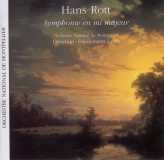Updated
on
January 4, 2025 |
 |
 |
 |
 |
 |
 |
 |
 |
 |
|
|
 |
 |
 |
 |
 |
 |
 |
| |
 |
|
| In an April 1997 concert performance from Amsterdam (Zondag
Ochtend ZOC 9702), Jac van Steen favors bracing tempi, to tonic
effect. The slow movement's final chorale is light and magically
airborne, the brasses achieve a real Mahlerian whooping élan in the Scherzo, and the Finale, sailing into the propulsive
fugues, is unusually cohesive. But van Steen lacks the technical
know-how - or, perhaps, had insufficient rehearsal time - to
carry off his ambitious conception. The indicated ritards and
rubatos sound ungainly and disproportionate; the insufficiently
sorted-out tuttis suffer haphazard balances and even random
tempi. In the turbulent explosion that closes the Scherzo,
the overlapping motifs are all over the place. A messy scramble
precedes the Finale's half-cadence. The Netherlands Radio players
sound overtaxed as well. Flute and trumpet intonation at the
start is iffy; the violins are scrappy in the flourishes and
nervous elsewhere; in the Finale, after the impeccably placed
low D-sharp in contrabassoon and tympani, the basses can't
zero in on the resolving E (too many mistuned four-string basses?).
The clean, focused bass reproduction is an advantage in the
Finale's opening, where the low bits sound less murky than
usual, but the harsh, coarse, cutting tutti sound - surprising
in the Concertgebouw acoustic - makes for difficult listening. |

Radio Filharmonisch
Orkest
Jac van Steen
|
| The schizophrenic 2000 performance by the Orchestre National
de Montpellier (Naïve AD 085) sounds pieced together from
two different conductors, one sensitive, the other cloddish.
Friedemann Layer's stiff, sluggish timebeating serves the first
two movements poorly. The opening theme slogs along laboriously,
with no exhiliration at the climax, and no real flow anywhere
else - even the quieter moments are wooden. Both the soft and
the loud statements of the Sehr langsam theme are bass-heavy,
and the 4/4 chorale arrives deadpan, just another meaningless
episode. After this, the genuine uplift of the Scherzo is a
pleasant surprise. So is the Finale, to begin with: the introduction's
misterioso aspect comes across well, and the woodwind passages
are suitably liquid. Unfortunately, the striding theme reverts
to hacking away, just one damned beat after the next. The sound
conveys a good sense of depth, so the various instrumental
strands combine into attractive layered textures. But the engineers
haven't solved the problem of hard-edged, congested tuttis. |

Orchestre National
de Montpellier
Friedemann Layer
|
| Part 8 |
|
Back to Part 6
|
|